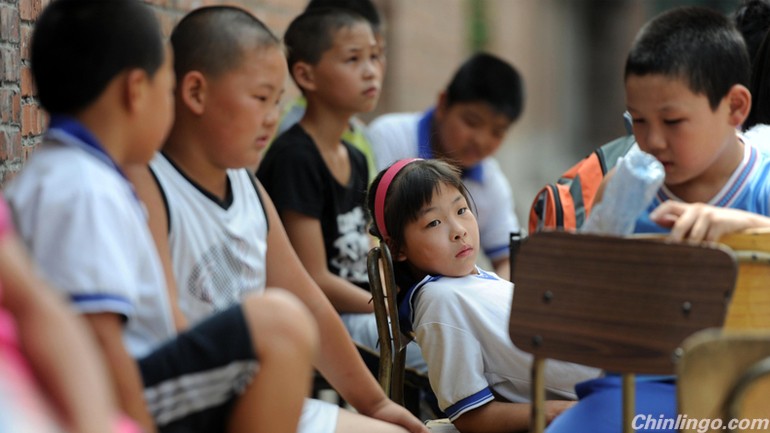
In the last decade, China's serious gender imbalance has made headlines: millions of Chinese men are doomed to bachelorhood due to a shortage of women, with awful social consequences. The conventional wisdom is that this skewing — a sex ratio at birth far higher than the natural ratio of 105 males to 100 females — is caused simply and solely by China's one-child policy. Given Chinese parents' supposedly ancient cultural preference for sons, the argument goes, if they can only have one child, it had better be a boy. That the sex ratio started skewing around 1985, about five years into the new birth planning policy, seems proof enough. The claim's logical conclusion is that abolishing the policy will eliminate China's sex ratio imbalance.
在过去10年里,中国严重的男女比例失衡引起媒体关注:由于男多女少,数以百万计的中国男子注定要独身,由此带来可怕的社会后果。中国的新生儿男女比例远远高于105:100的自然比率,流行看法是,这纯粹、完全是由中国的独生子女政策造成的。这种观点认为,中国家长自古以来重男轻女,如果他们只能有一个孩子,那最好是个男孩。男女比例从计划生育政策实施约五年后的1985年左右开始失调似乎足以证明。这种说法合乎逻辑的结论是:取消该政策将消除中国的男女比例失衡。
But some basic comparisons show us how the conventional wisdom is faulty. The claim that the skewed sex ratio has occurred due to the birth planning policy usually rests on two premises: that it alone caused fertility decline and that this fertility decline led to a skewed sex ratio at birth. But, in fact, China's fertility decline began in the early 1970s, years before the one-child policy. And, China's neighbours had similar fertility declines in the 1970, even without such draconian policies.
但稍做比较就能看出这种流行看法是错误的。男女比例失调起因于计划生育政策的说法通常有两个前提依据:单单这一个因素导致了人口出生率下降,人口出生率的下降导致了新生儿男女比例失调。但事实上,中国的人口出生率在20世纪70年代初就开始下降,那是独生子女政策出台的好几年前。而且,中国的邻国尽管没有实施这种严厉的政策,但在1970年也曾出现类似的人口出生率下降。
Fertility declines also do not inevitably lead to a skewed sex ratio. Japan's fertility rate has been among the world's lowest for nearly two decades, but its sex ratio at birth has remained in the natural range. While China's skewed sex ratio of the past three decades does coincide with the start of the birth planning policy, this coincidence is somewhat misleading. A longer historical view reveals that China's sex ratio was terribly skewed over much of the last two centuries.
人口出生率下降也并非必然导致男女比例失调。日本的人口出生率约20年来一直是世界上最低的,但该国的男女比例始终保持在自然范围内。中国过去30年里的男女比例失调恰好与计划生育政策的实施同步,这种巧合具有误导性。从更久远的历史角度来看,中国的男女比例是在过去200年的很长时间内渐渐严重失调的。
The one-child policy itself is a bit of a misnomer: three distinct policy variations are in place across China. Rural, majority-Han areas practice a '1.5-child' policy, in which families whose first child is a girl are allowed a second in hopes of having a boy. Urban areas have a strict one-child limit, while poor ethnic-minority areas have a two-child limit.
独生子女政策本身有点用词不当,其实中国各地有三种不同政策。以汉人为主的农村地区实行"1.5胎"政策,头胎是女孩的家庭可以怀着对儿子的期盼生二胎。城镇地区执行严格的独生子女规定,贫穷的少数民族地区则限生两个孩子。
Sex ratio skewing is higher in rural 1.5-child policy areas (about 119:100 at birth) than in urban one-child areas (about 115:100), and is lowest in two-child policy areas (about 112:100). These numbers indicate that switching to a universal two-child policy would reduce but not eliminate the problem: China's sex ratio at birth would still be higher than almost anywhere else in the world. So there is some truth to the conventional wisdom, but the birth planning policy is not the only important driver of sex ratio skewing.
就男女比例失调程度而言,农村"1.5胎"地区(新生儿男女比例约为119:100)高于城镇独生子女地区(约115:100),限生两个孩子的地区(约112:100)最低。这些数字表明,转而普遍实行二胎政策可缓解但不能消除问题:中国的新生儿男女比例仍会高于世界上其他几乎所有地方。因此,流行看法有一定道理,但计划生育政策不是男女比例失调的唯一重要推动力。
The problem with the conventional wisdom is that it treats son preference as a cultural given: it says Chinese people just prefer sons. But son preference is not a constant. Incentives for Chinese families to have sons have changed considerably over time, rising and falling in tandem with a skewed sex ratio at birth. So efforts to normalise China's sex ratio at birth ought to attack existing incentives for families to have sons.
流行看法的问题在于,它把重男轻女当成一个司空见惯的文化现象,认为中国人就是喜欢儿子。但重男轻女并非永恒不变的定律。刺激中国家庭生儿子的因素随着时间的推移几经沉浮,与新生儿男女比例失调状况同步。因此,要使中国的新生儿男女比例正常化,就应当着手解决中国父母想生儿子的刺激因素。
Son preference incentives appear in four realms: labour, property ownership and inheritance, ritual life, and old-age security. Societies with strong incentives in these areas tend to have a skewed sex ratio. Indeed, differences in the sex ratio at birth parallel differences in levels of son preference incentives through time, across regions of China and across countries. Old-age security seems to be the most important driver of son preference, while ritual-related incentives matter less.
重男轻女的诱因出现在四个领域:劳动、财产所有权和继承权、祭祀活动、养老保障。在这些领域有强大刺激因素的社会往往男女比例失调。事实上,无论是从中国各地来看还是从各个国家来看,新生儿男女比例的差异与重男轻女刺激因素强烈程度的差异总是一致的。养老保障似乎是重男轻女的最重要诱因,与祭祀有关的诱因次之。
China's sex ratio at birth was skewed before 1960, normal during 1960–85 and skewed again after 1985. In both periods of high skewing, sons were highly necessary on all four measures: for farm labour, property inheritance, ancestor worship and old-age care. In contrast, during the commune era (approximately 1958–83), production was socialised, property was collectivised, ancestor worship was suppressed and pensions for the elderly were provided by the commune. Families didn't require sons, and so they had little incentive to practice female infanticide or abandonment.
中国的新生儿男女比例在1960年之前失调,1960年至1985年间正常,1985年以后再度失调。在高度失调的这两个时间段里,儿子以全部四个标准来衡量都十分必要:下地劳动、财产继承、祭祖和养老。相比之下,在公社时期(约1958年至1983年)期间,生产活动社会化,财产归集体,祭祖活动遭压制,养老金由公社提供。家庭不需要儿子,所以他们没有什么动力去杀死或遗弃女婴。
Since the mid-1980s, son preference incentives have differed starkly between urban and rural areas of China. In urban areas, educated women make important economic contributions to their birth families and are thus able to provide old-age care for their parents. Ancestor worship is also less relevant to urban life compared to rural areas, while urban women also share equally in property and inheritance. Altogether, these factors mean that urban families have less incentive than rural ones to prefer sons.
上世纪80年代中期以来,重男轻女的刺激因素在中国形成显著的城乡差别。在城镇地区,受过良好教育的女性是生父母家庭的重要经济支柱,因而能够为父母提供养老。祭祖活动在城镇不像在农村那么重要,而城镇女性也享有平等的财产权和继承权。综合这些因素,城里人不像农村人那么渴盼生儿子。
The sex ratio at birth has also changed along with son preference incentives inJapan and South Korea. Japan scores low on our measures of son preference throughout the 20th century. Women contribute meaningfully to family income and inherit property equally, and Japan has excellent old-age pensions. While sons are strongly preferred for family rituals, Japan's sex ratio at birth is not skewed. As a second example, South Korea saw a sharp increase in sex ratio skewing in the mid-1980s, followed by a decrease after 1995. This normalisation coincided with changes in South Korean family law specifying that women did not have to marry into their husbands' families, had equal rights and responsibilities in ancestor worship and equal inheritance rights.
日本和韩国的新生儿男女比例也随着重男轻女刺激因素的变化而变化。在整个20世纪,日本的重男轻女程度以我们的标准来衡量不高。女性对家庭收入有重大贡献并享有平等的财产权,而且日本的养老金很丰厚。虽然在祭祖时最好有儿子,但日本的新生儿男女比例并未失调。另一个例子是,韩国的男女比例失调在上世纪80年代中期曾急剧上升,但1995年以后下降。这种正常化恰逢韩国的婚姻家庭法规定,女性不一定要嫁入夫家,她们有同等的祭祖权利和责任以及平等的继承权。
Normalising China's skewed sex ratio will require a concerted effort to reduce son preference, targeting policies and institutions that create these incentives. Simply haranguing Chinese citizens to change their 'backward' ways of thinking and culture will not suffice.
纠正中国的男女比例失调需要共同努力减少重男轻女现象,着眼于造就重男轻女诱因的政策和制度。一味长篇大论地教导中国公民转变"落后"思想和习俗是不够的。



 闽公网安备 35020302035673号
闽公网安备 35020302035673号
0 responses on "One-child policy not the sole reason for China's skewed sex ratio"